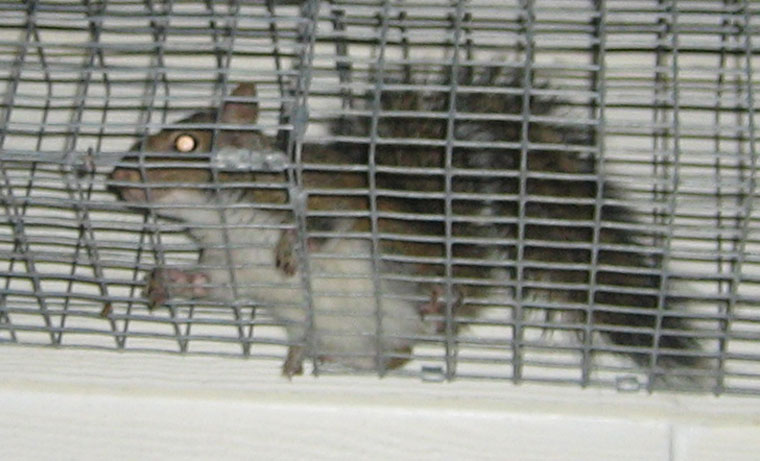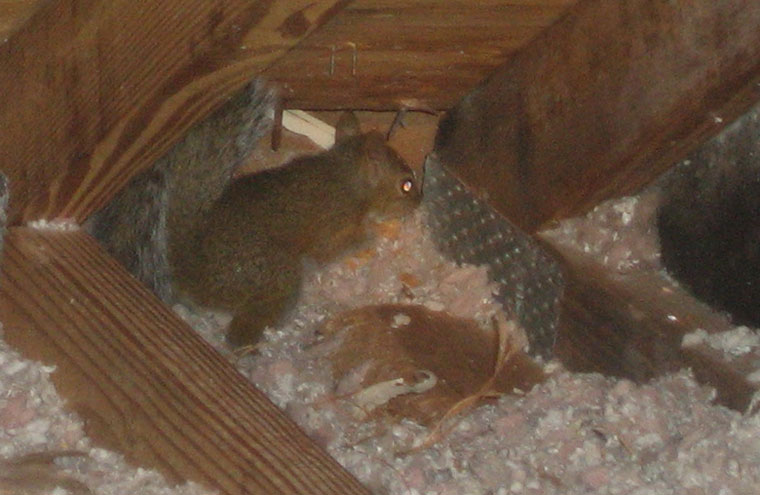- info@wildlife-removal.com
Call us for help in your town
Wildlife Removal Education
How long does it take to get rid of squirrels or squirrel nests?
Need squirrel removal in your hometown? We service over 500 USA locations! Click here to hire us in your town and check prices - updated for year 2020.
The speed at which you are able to get rid of your squirrel problem will be dictated by the method you use. Different scenarios will require different fixes — removal and prevention approaches — and using the wrong one will just lengthen the time that the squirrel is hanging around.

If you use wildlife control exterminators ...
This is generally considered to be the easiest and quickest way to get rid of squirrels from both commercial and residential properties, and in some cases, it can even be the cheapest approach too. (Despite what you might have heard on the grapevine.)
Wildlife control exterminators or removal experts can usually offer same-day appointments, which means that your squirrel problem could be solved that very same day. If the squirrel is alone, is easy to find, or the rehabber is lucky enough to find a mother plus the nest full of babies all together, the entire problem can be grabbed and removed in one foul swoop, leaving just repair work and cleaning left behind.
Check with your local nuisance animal control officers — many offer certain repair works and waste removal/cleanup included the quote.
If you use repellents ...
In reality, using repellents to get rid of nuisance animal issues isn’t going to work. At first thought, it seems like the perfect solution — you can evict the animal and make sure that it doesn’t return to that spot. It doesn’t take long for you to realize your mistake, however; not only do repellents not work in almost all cases, but they prove to be VERY expensive over the long time.
One $20 bottle or item is affordable. When that original $20 cost turns into $20 a week or every couple of days, the cost soon increases ... As does the length of time it takes for you to successfully get rid of the squirrel or squirrels you have on your property. Products or devices that do not work prevent you from getting rid of squirrels at all.
If you use trapping methods ...
You have two options when it comes to trapping — you can humanely catch the squirrel in a live cage trap, before then releasing it into the wild, handing it over to control exterminators, or killing it humanely and quickly on your property; or you can kill trap the squirrel. We recommend reviewing local laws before deciding on a trapping method — they may restrict what you can and can’t do.
Traps, both kill and live traps, will not work unless you put them in the right spots. An incorrectly placed trap will catch nothing after a few weeks. A well placed trap can see results in just a few hours.
Alongside trap placement, bait, and surroundings are also important.
If you use exclusion devices ...
Just like traps, exclusion devices are a very effective squirrel removal approach when used properly, and can have success (excluded/evicted squirrels) in a matter of hours. Bait is not important with exclusion devices, although, it can help to speed up the process. You will need to check that you are placing these devices on holes or in areas that the squirrel would usually use to get in and out. In theory, you can seal up all smaller holes, leaving just one or two open and with exclusion devices attached.
If you have a nest of squirrels ...
A mother with kits or kittens (baby squirrels) in a nest will mean that all of the above methods are virtually useless, with the exception of one — wildlife eviction fluid. This repellent is usually all-natural, relying on the scents of squirrel predators to scare them away.
Wildlife eviction fluid (also known as raccoon eviction fluid or just eviction fluid) will not offer up a flawless squirrel removal project, but can encourage movement from the sidelines. With any luck the mother will simply grab her kits and run, moving them along to a brand new nest spot that doesn’t cause you quite so many problems.
Wildlife eviction fluid can work within a few hours, once again, but only when it is used correctly. It is not guaranteed to work and will not KEEP squirrels out. You must do that, by sealing up the building properly and with the right, durable materials.
How long does it take to get rid of squirrels? Well, that just depends on you and the approach you take. Which ones sounds like the right one to you?
What do squirrel nests look like? (And how to safely get rid of them.)
Young squirrels, also known as either kittens or kits, will stick with their mother and stay in the absolutely safety and warmth of the nest for at lest six weeks. The bravest of kits will leave the nest entirely, read to start life on their own, at about twelve weeks of age, although, many of them will stay a little longer than that. Female kits are known to stay with their mothers for longer than male kits are, the latter being eager to get out and start exploring, hunting for a mate of all of their own.

This means that you have a twelve-week period where almost all squirrel nests will contain kits — baby squirrels. Moving or killing them isn’t easy during this time, and what can make life doubly difficult for you — the person trying to get rid of them — is that some squirrels can have not just the one litter in a year, but two. If that is the case, the nest will be inhabited for 24 weeks minimum, rather than just 12. You can’t exclude or trap squirrels while the nest contains kits, so not knowing squirrel mating timing can be detrimental to you if you continually have a problem with them.
Early spring when the weather turns nice is when squirrels will have their first litter, and this period will change depending on where you are across the United States. The second litter is usually born closer to the end of summer — around the end of July and heading into August. Count three months forward from that point and you will have just about prime squirrel eviction time.
What happens if I try to get rid of a squirrel and the nest at the wrong time of year?
There is a long list of things that might (and usually do) go wrong if you pick the wrong time to remove the squirrels from your property:
1 - you might evict, trap or kill a female mother squirrel, leaving her kits in a nest to starve to death
2 - you might evict, trap or kill an endangered species (if you do not know what kind of squirrel you are trying to get rid of it, different species have different laws attached to them)
3 - you might leave the newly-available space open to other wild animals, including rodents
4 - you might have ZERO luck when it comes to actually getting rid of the squirrel(s)
What do squirrel nests look like?
Squirrel nests look very much like bird nests, but slightly larger. In fact, some squirrel nests (for example, Eastern Grey squirrels) can be over two feet wide — it depends on how established the nesting site is, how well protected it is, and how long the space has been left wide open for the squirrels. A large nest would indicate that the squirrel has had plenty of time to create it, meaning it has been hanging around for a while. (The more established the squirrel is in that particular territory, the more damage will be caused and the harder it will be to get rid of them.)
Nests are often started with a basic framework made up of twigs, branches and other similar garden debris and material, which are then woven together. To add insulation and further protection, the squirrel will build the nest up, using moss and leaves, as well as a number of other soft and easily moldable materials, and these are best used damp and then left to dry in shape. More plant material is added to make the space more comfortable, and if the squirrel has a chance to add more soft stuffing, it will. This can include attic insulation, chewed/shredded paper or cardboard, old photographs, clothes, soft furnishings and other materials, soft wood, etc. In short, your personal belongings are going to come under attack.
Go back to the Squirrel Removal page, or learn tips to do it yourself with my How to Get Rid of Squirrels guide.


















